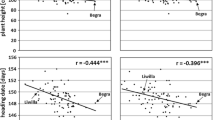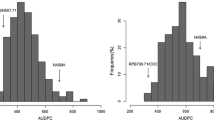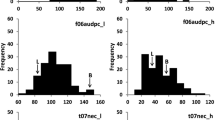Abstract
Breeding for resistance to Septoria tritici blotch (STB), caused by Mycosphaerella graminicola (anamorph: Septoria tritici), is an essential component in controlling this important foliar disease of wheat. Inheritance of seedling resistance to seven worldwide pathogen isolates has been studied in a doubled-haploid (DH) population derived from a cross between the field resistant cultivar Solitär and the susceptible cultivar Mazurka. Multiple quantitative trait locus (QTL) mapping revealed major and minor genetic effects on resistance as well as several epistatic relationships in the seedling stage. Solitär conferred resistance to isolate IPO323, governed by Stb6 on chromosome 3A, as well as to IPO99015, IPO92034, Hu1 and Hu2 controlled by a QTL on chromosome arm 1BS, possibly corresponding to Stb11 and minor QTL on chromosomes 1B, 3D, 6B and 7D. Resistance of Mazurka to IPO90015 and BBA22 was caused by a QTL located in a region on 4AL which harbours Stb7 or Stb12. QTL specific to pycnidial coverage on 3B and specific to necrosis on 1A could be discovered for isolate IPO92034. Pairwise epistatic interactions were reliably detected with five isolates. Although their contributions to the total variance are generally low, the genotypic effect of the QTL by QTL interaction of 4AL (Stb7 or Stb12) and 3AS (Stb6) made up almost 15% of disease expression. Altogether, the results suggest a complex inheritance of resistance to STB in the seedling stage in terms of isolate-specificity and resistance mechanisms, which have implications for marker-assisted breeding in an attempt to pyramid STB resistance genes.




Similar content being viewed by others
References
Adhikari TB, Wallwork H, Goodwin SB (2004a) Microsatellite markers linked to the Stb2 and Stb3 genes for resistance to Septoria tritici blotch in wheat. Crop Sci 44:1403–1411
Adhikari TB, Cavaletto JR, Dubcovsky J, Gieco JO, Schlatter AR, Goodwin SB (2004b) Molecular mapping of the Stb4 gene for resistance to Septoria tritici blotch in wheat. Phytopathology 94:1198–1206
Adhikari TB, Balaji B, Breeden J, Goodwin SB (2007) Resistance to Mycosphaerella graminicola involves early and late peaks of gene expression. Physiol Mol Plant Pathol 71:55–68
Anomymous (2004) Beschreibende Sortenliste. Bundessortenamt, Hannover
Arraiano LS, Brown JKM (2006) Identification of isolate-specific and partial resistance to Septoria tritici blotch in 238 European wheat cultivars and breeding lines. Plant Pathol 55:726–738
Arraiano LS, Worland AJ, Ellerbrook C, Brown JKM (2001) Chromosomal location of a gene for resistance to Septoria tritici blotch (Mycosphaerella graminicola) in the hexaploid wheat ‘Synthetic 6x’. Theor Appl Genet 103:758–764
Arraiano LS, Chartrain L, Bossolini E, Slatter HN, Keller B, Brown JKM (2007) A gene in European wheat cultivars for resistance to an African isolate of Mycosphaerella graminicola. Plant Pathol 56:73–78
Arraiano LS, Balaam N, Fenwick PM, Chapman C, Feuerhelm D, Howell P, Smith SJ, Widdowson JP, Brown JKM (2009) Contributions of disease resistance and escape to the control of septoria tritici blotch of wheat. Plant Pathol 58:910–922
Brading PA, Verstappen ECP, Kema GHJ, Brown JKM (2002) A gene-for-gene relationship between wheat and Mycosphaerella graminicola, the Septoria tritici blotch pathogen. Phytopathology 92:439–445
Broman KW (2003) Mapping quantitative trait loci in the case of a spike in the phenotype distribution. Genetics 163:1169–1175
Broman KW, Wu H, Sen Ś, Churchill GA (2003) R/qtl: QTL mapping in experimental crosses. Bioinformatics 19:889–890
Chartrain L, Brading PA, Widdowson JP, Brown JKM (2004) Partial resistance to Septoria tritici blotch (Mycosphaerella graminicola) in wheat cultivars Arina and Riband. Phytopathology 94:497–504
Chartrain L, Berry ST, Brown JKM (2005a) Resistance of wheat line Kavkaz-K4500L.6.A.4 to Septoria tritici blotch controlled by isolate-specific resistance genes. Phytopathology 95:664–671
Chartrain L, Joaquim P, Berry ST, Arraiano LS, Azanza F, Brown JKM (2005b) Genetics of resistance to Septoria tritici blotch in the Portuguese wheat breeding line TE 9111. Theor Appl Genet 110:1138–1144
Chartrain L, Brading PA, Brown JKM (2005c) Presence of the Stb6 gene for resistance to Septoria tritici blotch (Mycosphaerella graminicola) in cultivars used in wheat-breeding programmes worldwide. Plant Pathol 54:134–143
Chartrain L, Sourdille P, Bernard M, Brown JKM (2009) Identification and location of Stb9, a gene for resistance to Septoria tritici blotch in wheat cultivars Courtot and Tonic. Plant Pathol 58:547–555
Cowger C, Mundt CC (2002) Effects of wheat cultivar mixtures on epidemic progression of Septoria tritici blotch and pathogenicity of Mycosphaerella graminicola. Phytopathology 92:617–623
Cowger C, Hoffer ME, Mundt CC (2000) Specific adaptation by Mycosphaerella graminicola to a resistant wheat cultivar. Plant Pathol 49:445–451
Doyle JJ, Doyle JL (1990) Isolation of plant DNA from fresh tissue. Focus 12:13–15
Eriksen L, Borum F, Jahoor A (2003) Inheritance and localisation of resistance to Mycosphaerella graminicola causing Septoria tritici blotch and plant height in the wheat (Triticum aestivum L.) genome with DNA markers. Theor Appl Genet 107:515–527
Eyal Z, Scharen AL, Prescott JM, Van Ginkel M (1987) The Septoria diseases of wheat: concepts and methods of disease management. CIMMYT, Mexico
Fisher RA (1918) The correlations between relatives on the supposition of Mendelian inheritance. Trans R Soc Edinb 52:399–433
Fraaije BA, Cools HJ, Fountaine J, Lovell DJ, Motteram J, West JS, Lucas JA (2005) Role of ascospores in further spread of QoI-resistant cytochrome b alleles (G143A) in field populations of Mycosphaerella graminicola. Phytopathology 95:933–941
Ganal MW, Röder MS (2007) Microsatellite and SNP markers in wheat breeding. In: Varshney R, Tuberosa R (eds) Genomic-assisted crop improvement, genomics applications in crops, vol 2. Springer, Netherlands
Goodwin SB (2007) Back to basics and beyond: increasing the level of resistance to Septoria tritici blotch in wheat. Aust Plant Pathol 36:532–538
Gupta PK, Balyan HS, Edwards KJ, Isaac P, Korzun V, Röder M, Gautier M-F, Joudrier P, Schlatter AR, Dubcovsky J, De la Pena RC, Khairallah M, Penner G, Hayden MJ, Sharp P, Keller B, Wang RCC, Hardouin JP, Jack P, Leroy P (2002) Genetic mapping of 66 new microsatellite (SSR) loci in bread wheat. Theor Appl Genet 105:413–422
Guyomarch H, Sourdille P, Charmet G, Edwards KJ, Bernard M (2002) Characterisation of polymorphic microsatellite markers from Aegilops tauschii and transferability of the D-genome of bread wheat. Theor Appl Genet 104:1164–1172
Haley CS, Knott SA (1992) A simple regression method for mapping quantitative trait loci in line crosses using flanking markers. Heredity 69:315–324
Jackson LF, Dubcovsky J, Gallagher LW, Wennig RL, Heaton J, Vogt H, Gibbs LK, Kirby D, Canevari M, Carlson H, Kearney T, Marsh B, Munier D, Mutters C, Orloff S, Schmierer J, Vargas R, Williams J, Wright S (2000) Regional barley and common durum wheat performance tests in California. Agron Prog Rep 272:1–56
Jlibene M, Gustafson JP, Rajaram S (1994) Inheritance of resistance to Mycosphaerella graminicola in hexaploid wheat. Plant Breed 112:301–310
Jones JDG, Dangl JL (2006) The plant immune system. Nature 444:323–329
Kema GHJ, van Silfhout CH (1997) Genetic variation for virulence and resistance in the wheat-Mycosphaerella graminicola pathosystem III. Comparative seedling and adult plant experiments. Phytopathology 87:266–272
Kema GHJ, Yu D, Rijkenberg HJ, Shaw MW, Baayen RP (1996a) Histology of the pathogenesis of Mycosphaerella graminicola in wheat. Phytopathology 86:777–786
Kema GHJ, Annone JG, Sayoud R, van Silfhout CH, van Ginkel M, de Bree J (1996b) Genetic variation for virulence and resistance in the wheat-Mycosphaerella graminicola pathosystem. I. Interactions between pathogen isolates and host cultivars. Phytopathology 86:200–212
Kema GHJ, Verstappen ECP, Waalwijk C (2000) Avirulence in the wheat Septoria tritici leaf blotch fungus Mycosphaerella graminicola is controlled by a single locus. Mol Plant Microbe Interact 13:1375–1379
Keon J, Antoniw J, Carzaniga R, Deller S, Ward JL, Baker JM, Beale MH, Hammond-Kosack K, Rudd JJ (2007) Transcriptional adaptation of Mycosphaerella graminicola to programmed cell death (PCD) of its susceptible wheat host. Mol Plant Microbe Interact 20:178–193
Krenz JE, Sackett KE, Mundt CC (2008) Specificity of incomplete resistance to Mycospaerella graminicola in wheat. Phytopathology 98:555–561
Lander ES, Botstein D (1989) Mapping Mendelian factors underlying quantitative traits using RFLP linkage maps. Genetics 121:185–199
Lincoln SE, Daly MJ, Lander ES (1993) MAPMAKER/EXP. Whitehead Institute of Biomedical Research, Cambridge
McCartney CA, Brûlé-Babel AL, Lamari L, Somers DJ (2003) Chromosomal location of a race specific resistance gene to Mycosphaerella graminicola in the spring wheat ST6. Theor Appl Genet 691(107):1181–1186
McIntosh RA, Devos KM, Dubcovsky J, Rogers WJ, Morris CF, Appels R, Somers DJ, Anderson OA (2007) Catalogue of gene symbols for wheat: 2007 supplement. Annu Wheat Newsl 53:159–180
Mille B, Belhaj Fraj M, Monod H, de Vallavieille-Pope C (2006) Assessing four-way mixtures of winter wheat cultivars from the performances of their two-way and individual components. Eur J Plant Pathol 114:163–173
Palmer CL, Skinner W (2002) Mycosphaerella graminicola: latent infection, crop devastation and genomics. Mol Plant Pathol 3:63–70
Pestsova E, Ganal MW, Röder MS (2000) Isolation and mapping of microsatellite markers specific for the D genome of bread wheat. Genome 43:689–697
Poland JA, Balint-Kurti PJ, Wisser RJ, Pratt RC, Nelson RJ (2008) Shades of gray: the world of quantitative disease resistance. Trends Plant Sci 14:21–29
R Development Core Team (2009) R: A language and environment for statistical computing. R Foundation for statistical computing, Vienna
Raman R, Milgate AW, Imtiaz M-K, Raman H, Lisle C, Coombers N, Martin P (2009) Molecular mapping and physical location of major gene conferring seedling resistance to Septoria tritici blotch in wheat. Mol Breed 24:153–164
Rillo AO, Caldwell RM (1966) Inheritance of resistance to Septoria tritici in Triticum aestivum subsp. vulgare ‘Bulgaria 88’. Phytopathology 56:897 (Abstract)
Röder MS, Korzun V, Wendehake K, Plaschke J, Tixier M-H, Leroy P, Ganal MW (1998) A microsatellite map of wheat. Genetics 149:2007–2023
Shaner G, Finney RE (1977) The effect of nitrogen fertilization on the expression of slow mildewing resistance in Knox wheat. Phytopathology 67:1051–1056
Shetty NP, Kristensen BK, Newman M-A, Møller K, Gregersen PL, Jørgensen HJL (2003) Association of hydrogen peroxide with restriction of Septoria tritici in resistant wheat. Physiol Mol Plant Pathol 62:333–334
Simón MR, Cordo CA (1998) Diallele analysis of four resistance components to Septoria tritici in six crosses of wheat (Triticum aestivum). Plant Breed 117:123–126
Simón MR, Ayala FM, Cordo CA, Röder MS, Börner A (2004) Molecular mapping of quantitative trait loci determining resistance to Septoria tritici blotch caused by Mycosphaerella graminicola in wheat. Euphytica 138:41–48
Simón MR, Perelló AE, Cordo CA, Larrán S, van der Putten P, Struik PC (2005) Association between Septoria tritici blotch, plant height, and heading date in wheat. Agron J 97:1072–1081
Somasco OA, Qualset CO, Gilchrist DG (1996) Single-gene resistance to Septoria tritici blotch in the spring wheat cultivar ‘Tadinia’. Plant Breed 115:261–267
Song QJ, Shi JR, Singh S, Fickus EW, Costa JM, Lewis J, Gill BS, Ward R, Cregan PB (2005) Development and mapping of microsatellite (SSR) markers in wheat. Theor Appl Genet 110:550–560
Sourdille P, Gandon B, Chiquet V, Nicot N, Somers D, Murigneux A, Bernard M (2004a) Wheat genoplante SSR mapping data release: a new set of markers and comprehensive genetic and physical mapping data. http://wheat.pw.usda.gov/ggpages/SSRclub/GeneticPhysical (validated 20th April 2011)
Sourdille P, Singh S, Cadalen T, Brown-Guedira GL, Gay G, Qi L, Gill BS, Dufour P, Murigneux A, Bernard M (2004b) Microsatellite-based deletion bin system for the establishment of genetic-physical map relationships in wheat (Triticum aestivum L.). Funct Integr Genom 4:12–25
Tabib Ghaffary SM, van der Lee TAJ, Verstappen ECP, Kema GHJ (2008) Screening for resistance to Septoria tritici blotch, the major wheat disease in Western Europe. 7th international Mycosphaerella and Stagonospora symposium, 18–22 August, Ascona, Switzerland
Tranquilli GE, Dubcovsky J (2000) Epistatic interaction between vernalization genes Vrn-A m 1 and Vrn-A m 2 in diploid wheat. J Hered 91:304–306
van Ginkel M, Scharen AL (1987) Generation mean analysis and heritabilities of resistance to Septoria tritici in durum wheat. Phytopathology 77:1629–1633
Voorrips RE (2002) Map chart: software for the graphical presentation of linkage maps and QTLs. J Hered 93:77–78
Vos P, Hogers R, Bleeker M, Reijans M, van de Lee T, Hornes M, Frijters A, Pot J, Peleman J, Kuiper M, Zabeau M (1995) AFLP: a new technique for DNA fingerprinting. Nucleic Acids Res 23:4407–4414
Wilson RE (1985) Inheritance of resistance to Septoria tritici in wheat. In: Scharen AL (ed) Septoria of cereals—proceedings of the second international Septoria workshop. 2–4 August 1983, Bozeman, Montana, USA, pp 33–35
Zeng Z-B (1994) Precision mapping of quantitative trait loci. Genetics 136:1457–1468
Zhan J, Pettway RE, McDonald BA (2003) The global genetic structure of the wheat pathogen Mycosphaerella graminicola is characterized by high nuclear diversity, low mitochondrial diversity, regular recombination, and gene flow. Fungal Genet Biol 38:286–297
Zhan J, Stefanato FL, McDonald BA (2006) Selection for increased cyproconazole tolerance in Mycosphaerella graminicola through local adaptation and in response to host resistance. Mol Plant Pathol 7:259–268
Acknowledgments
We thank Hubert Kempf (Secobra Saatzucht, Feldkirchen) and Laszlo Láng (ARI Martonvásár) for providing seed of Solitär and Mazurka, and express thanks to John Speakman (BASF Ludwigshafen) and Bernd Rodemann (JKI Braunschweig) for providing fungal isolates. We are also indebted to Carsten Springmann and Viktor Korzun (KWS-Planta, KWS-Lochow) for successful establishment of the DH lines, and Genoplante-Valor (Evry, France) for supplying Xgpw microsatellite primers. The technical assistance of Sebastian Kosellek, Helga Sängerlaub, Brigitte Schröder and Bernd Kollmorgen is greatly acknowledged. We are also grateful to staff members of PRI Wageningen and of IPK Gatersleben. We say thanks to Tim March for critical reading of the manuscript. Funding of this research, conducted in the PlantResourceII framework, was supported by the Land Sachsen-Anhalt, project number FAZ: 3593B/0405T, and a DAAD fellowship to CK. S Mahmod Tabib G. is funded by GIE Bioplante and Fonds de Soutien à l’Obtention Végétale (FSOV), France.
Author information
Authors and Affiliations
Corresponding author
Electronic supplementary material
Below is the link to the electronic supplementary material.
Rights and permissions
About this article
Cite this article
Kelm, C., Ghaffary, S.M.T., Bruelheide, H. et al. The genetic architecture of seedling resistance to Septoria tritici blotch in the winter wheat doubled-haploid population Solitär × Mazurka. Mol Breeding 29, 813–830 (2012). https://doi.org/10.1007/s11032-011-9592-8
Received:
Accepted:
Published:
Issue Date:
DOI: https://doi.org/10.1007/s11032-011-9592-8




